2016 NISSAN MAXIMA RECOMMENDED
[x] Cancel search: RECOMMENDEDPage 362 of 401
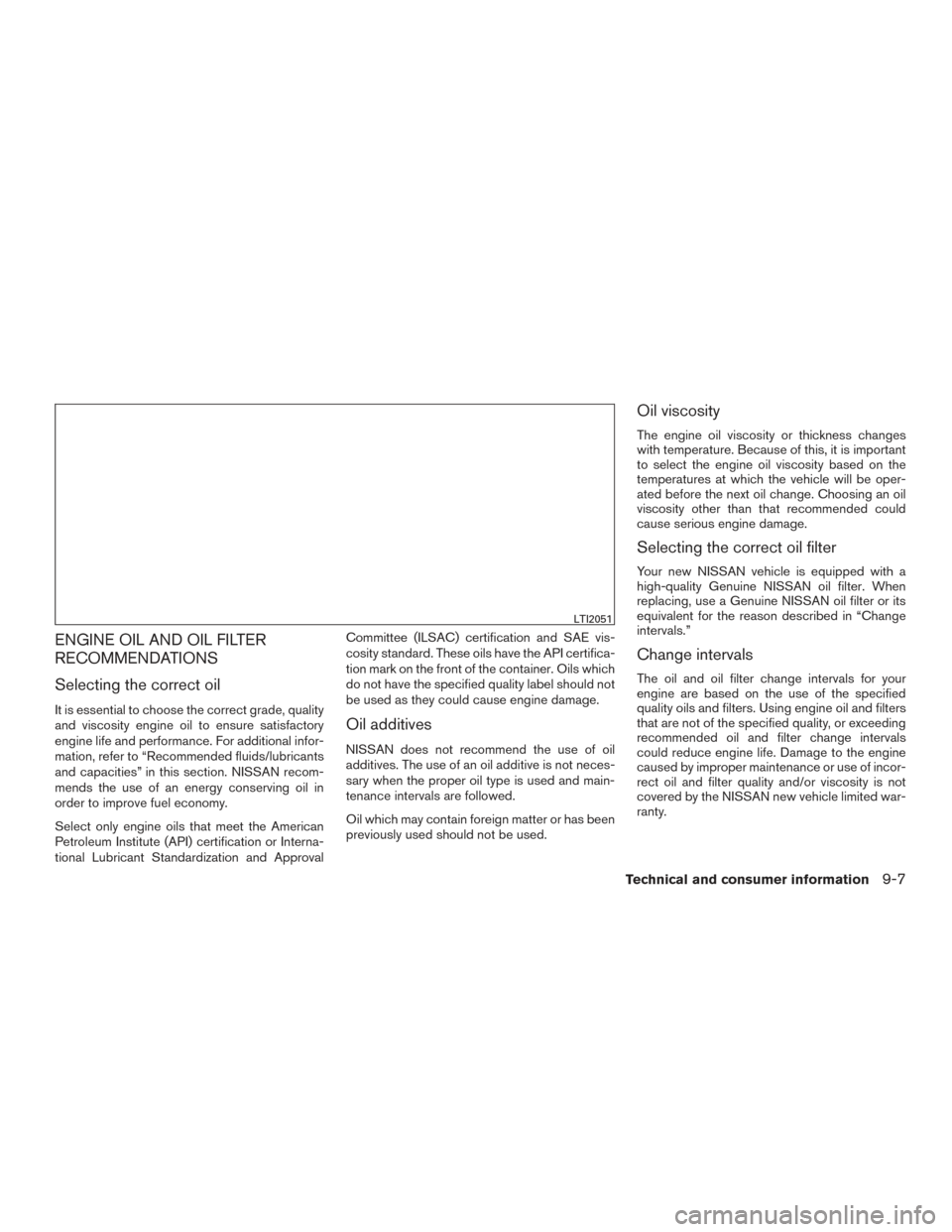
ENGINE OIL AND OIL FILTER
RECOMMENDATIONS
Selecting the correct oil
It is essential to choose the correct grade, quality
and viscosity engine oil to ensure satisfactory
engine life and performance. For additional infor-
mation, refer to “Recommended fluids/lubricants
and capacities” in this section. NISSAN recom-
mends the use of an energy conserving oil in
order to improve fuel economy.
Select only engine oils that meet the American
Petroleum Institute (API) certification or Interna-
tional Lubricant Standardization and ApprovalCommittee (ILSAC) certification and SAE vis-
cosity standard. These oils have the API certifica-
tion mark on the front of the container. Oils which
do not have the specified quality label should not
be used as they could cause engine damage.Oil additives
NISSAN does not recommend the use of oil
additives. The use of an oil additive is not neces-
sary when the proper oil type is used and main-
tenance intervals are followed.
Oil which may contain foreign matter or has been
previously used should not be used.
Oil viscosity
The engine oil viscosity or thickness changes
with temperature. Because of this, it is important
to select the engine oil viscosity based on the
temperatures at which the vehicle will be oper-
ated before the next oil change. Choosing an oil
viscosity other than that recommended could
cause serious engine damage.
Selecting the correct oil filter
Your new NISSAN vehicle is equipped with a
high-quality Genuine NISSAN oil filter. When
replacing, use a Genuine NISSAN oil filter or its
equivalent for the reason described in “Change
intervals.”
Change intervals
The oil and oil filter change intervals for your
engine are based on the use of the specified
quality oils and filters. Using engine oil and filters
that are not of the specified quality, or exceeding
recommended oil and filter change intervals
could reduce engine life. Damage to the engine
caused by improper maintenance or use of incor-
rect oil and filter quality and/or viscosity is not
covered by the NISSAN new vehicle limited war-
ranty.
LTI2051
Technical and consumer information9-7
Page 363 of 401
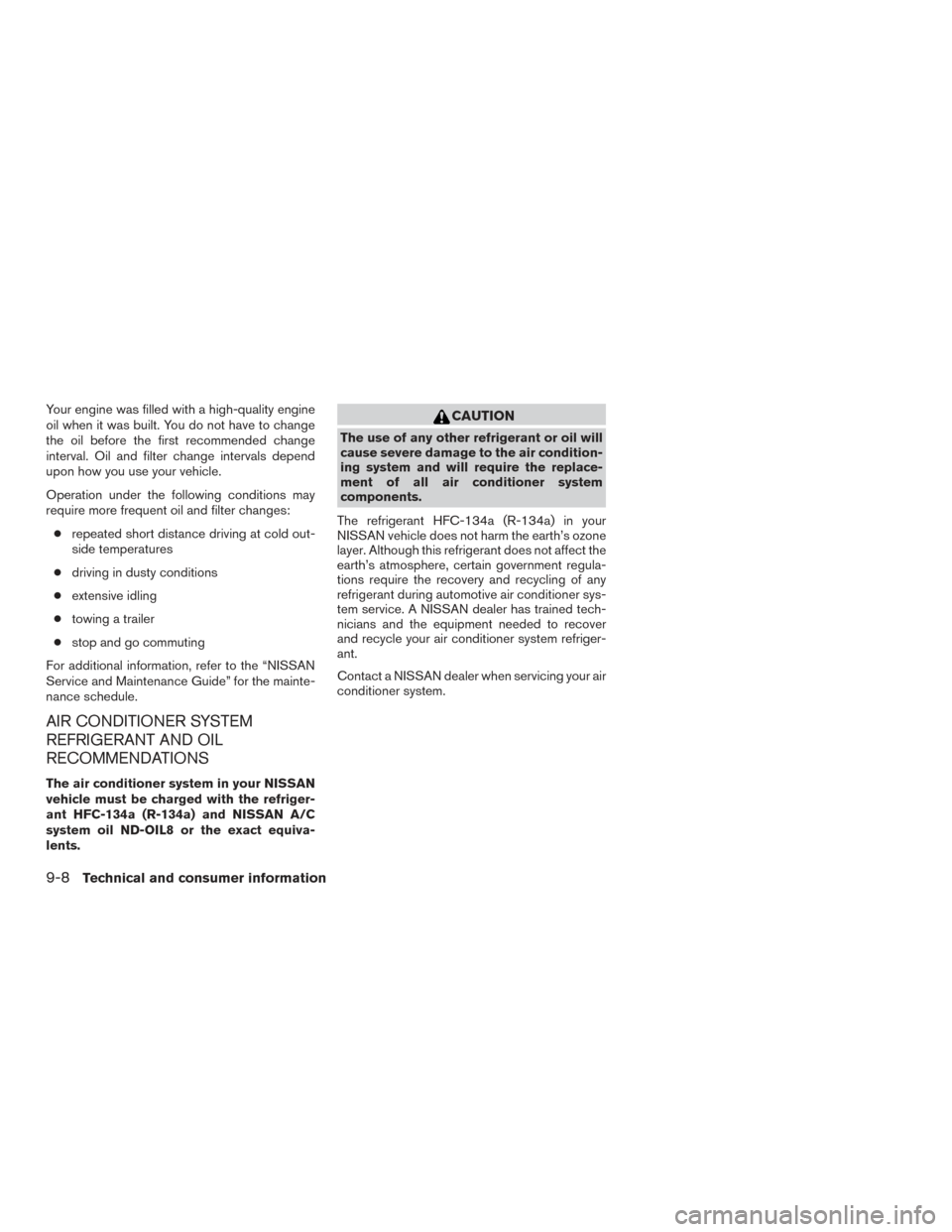
Your engine was filled with a high-quality engine
oil when it was built. You do not have to change
the oil before the first recommended change
interval. Oil and filter change intervals depend
upon how you use your vehicle.
Operation under the following conditions may
require more frequent oil and filter changes:● repeated short distance driving at cold out-
side temperatures
● driving in dusty conditions
● extensive idling
● towing a trailer
● stop and go commuting
For additional information, refer to the “NISSAN
Service and Maintenance Guide” for the mainte-
nance schedule.
AIR CONDITIONER SYSTEM
REFRIGERANT AND OIL
RECOMMENDATIONS
The air conditioner system in your NISSAN
vehicle must be charged with the refriger-
ant HFC-134a (R-134a) and NISSAN A/C
system oil ND-OIL8 or the exact equiva-
lents.
CAUTION
The use of any other refrigerant or oil will
cause severe damage to the air condition-
ing system and will require the replace-
ment of all air conditioner system
components.
The refrigerant HFC-134a (R-134a) in your
NISSAN vehicle does not harm the earth’s ozone
layer. Although this refrigerant does not affect the
earth’s atmosphere, certain government regula-
tions require the recovery and recycling of any
refrigerant during automotive air conditioner sys-
tem service. A NISSAN dealer has trained tech-
nicians and the equipment needed to recover
and recycle your air conditioner system refriger-
ant.
Contact a NISSAN dealer when servicing your air
conditioner system.
9-8Technical and consumer information
Page 373 of 401
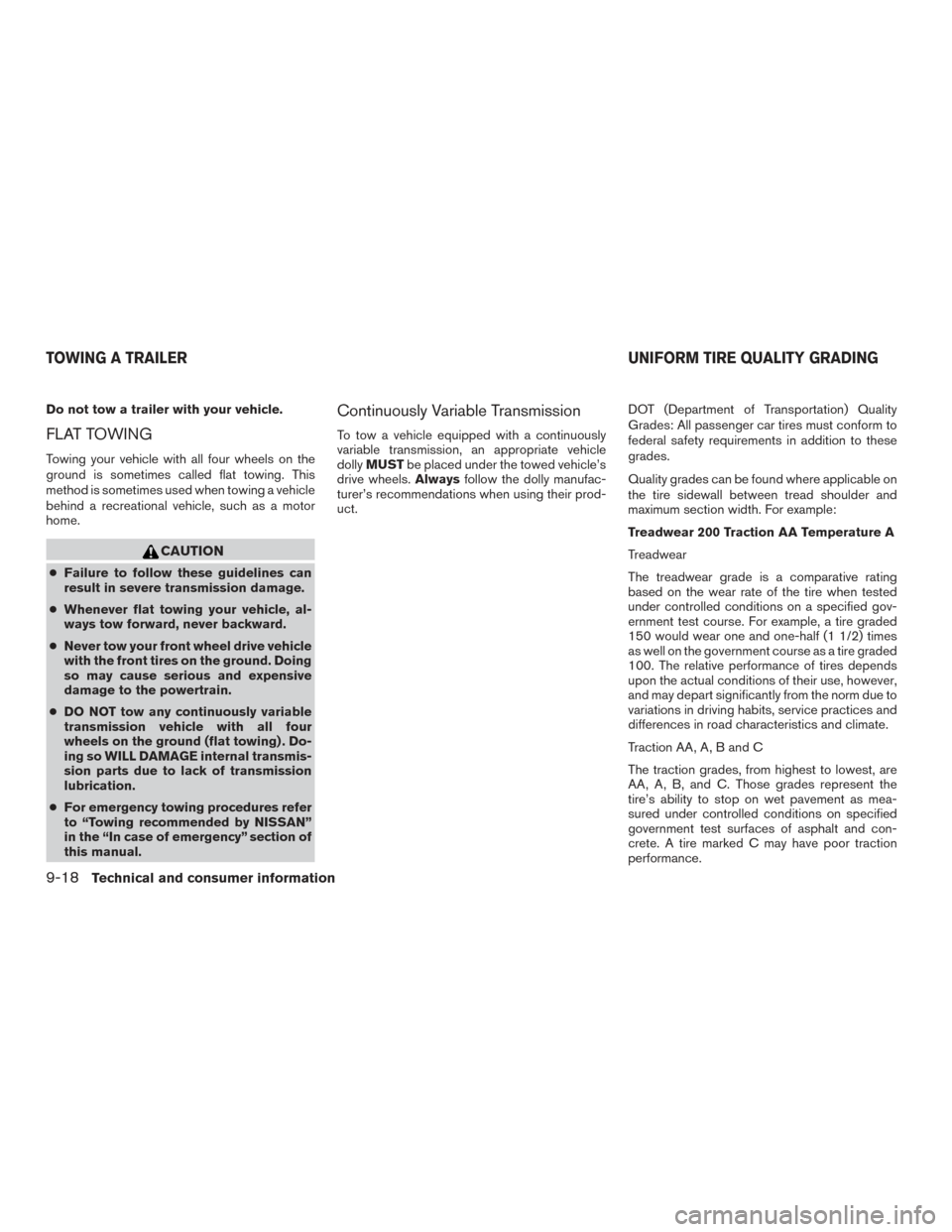
Do not tow a trailer with your vehicle.
FLAT TOWING
Towing your vehicle with all four wheels on the
ground is sometimes called flat towing. This
method is sometimes used when towing a vehicle
behind a recreational vehicle, such as a motor
home.
CAUTION
●Failure to follow these guidelines can
result in severe transmission damage.
● Whenever flat towing your vehicle, al-
ways tow forward, never backward.
● Never tow your front wheel drive vehicle
with the front tires on the ground. Doing
so may cause serious and expensive
damage to the powertrain.
● DO NOT tow any continuously variable
transmission vehicle with all four
wheels on the ground (flat towing) . Do-
ing so WILL DAMAGE internal transmis-
sion parts due to lack of transmission
lubrication.
● For emergency towing procedures refer
to “Towing recommended by NISSAN”
in the “In case of emergency” section of
this manual.
Continuously Variable Transmission
To tow a vehicle equipped with a continuously
variable transmission, an appropriate vehicle
dolly MUST be placed under the towed vehicle’s
drive wheels. Alwaysfollow the dolly manufac-
turer’s recommendations when using their prod-
uct. DOT (Department of Transportation) Quality
Grades: All passenger car tires must conform to
federal safety requirements in addition to these
grades.
Quality grades can be found where applicable on
the tire sidewall between tread shoulder and
maximum section width. For example:
Treadwear 200 Traction AA Temperature A
Treadwear
The treadwear grade is a comparative rating
based on the wear rate of the tire when tested
under controlled conditions on a specified gov-
ernment test course. For example, a tire graded
150 would wear one and one-half (1 1/2) times
as well on the government course as a tire graded
100. The relative performance of tires depends
upon the actual conditions of their use, however,
and may depart significantly from the norm due to
variations in driving habits, service practices and
differences in road characteristics and climate.
Traction AA, A, B and C
The traction grades, from highest to lowest, are
AA, A, B, and C. Those grades represent the
tire’s ability to stop on wet pavement as mea-
sured under controlled conditions on specified
government test surfaces of asphalt and con-
crete. A tire marked C may have poor traction
performance.
TOWING A TRAILER
UNIFORM TIRE QUALITY GRADING
9-18Technical and consumer information
Page 378 of 401
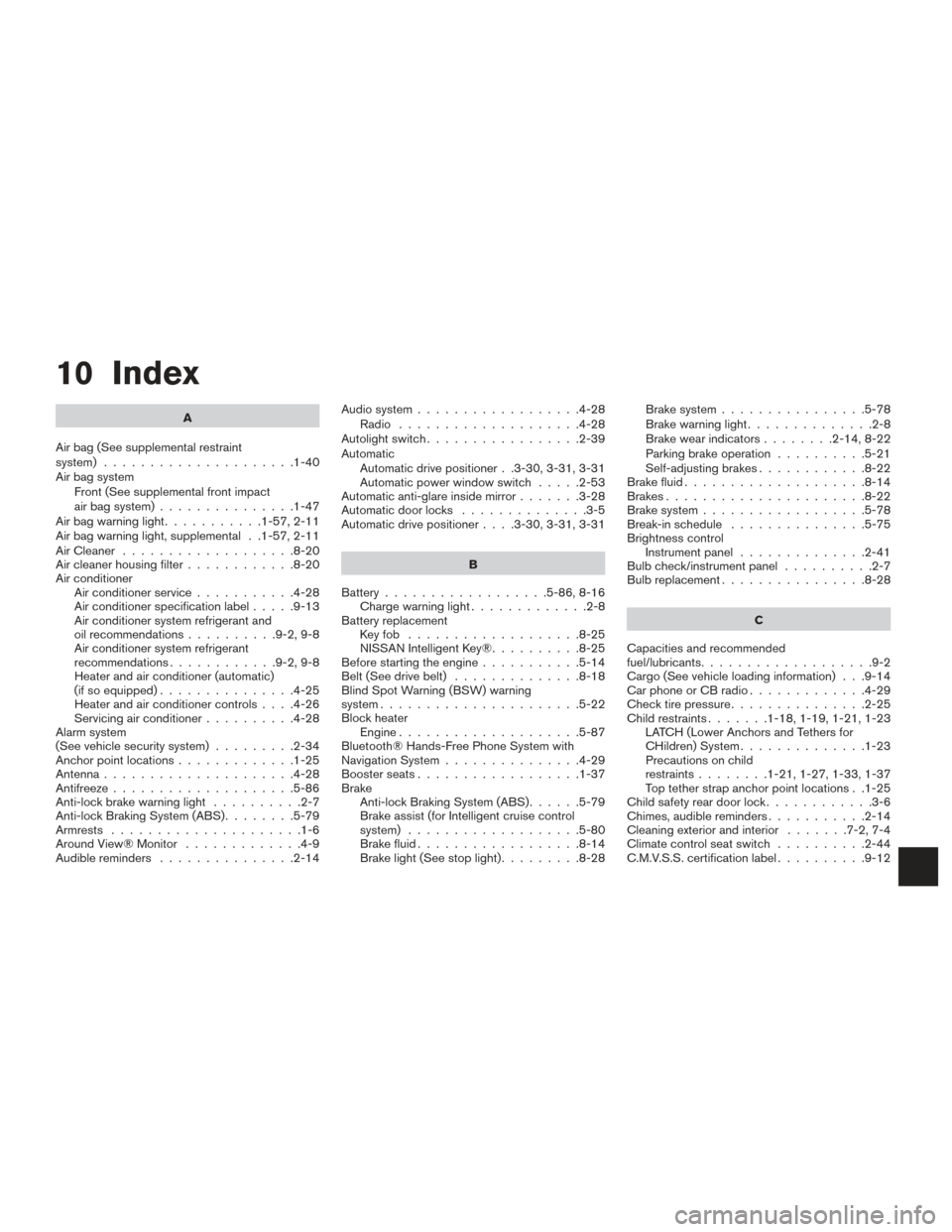
10 Index
A
Air bag (See supplemental restraint
system) .....................1-40
Air bag system Front (See supplemental front impact
air bag system) ...............1-47
Airbagwarninglight...........1-57,2-11
Air bag warning light, supplemental . .1-57, 2-11
AirCleaner ...................8-20
Air cleaner housing filter ............8-20
Air conditioner Air conditioner service ...........4-28
Air conditioner specification label .....9-13
Air conditioner system refrigerant and
oil recommendations ..........9-2,9-8
Air conditioner system refrigerant
recommendations ............9-2,9-8
Heater and air conditioner (automatic)
(if so equipped) ...............4-25
Heater and air conditioner controls ....4-26
Servicing air conditioner ..........4-28
Alarm system
(See vehicle security system) .........2-34
Anchor point locations .............1-25
Antenna .....................4-28
Antifreeze ....................5-86
Anti-lock brake warning light ..........2-7
Anti-lock Braking System (ABS) ........5-79
Armrests .....................1-6
Around View® Monitor .............4-9
Audible reminders ...............2-14 Audio system
..................4-28
Radio ....................4-28
Autolight switch .................2-39
Automatic Automatic drive positioner . .3-30, 3-31, 3-31
Automatic power window switch .....2-53
Automatic anti-glare inside mirror .......3-28
Automatic door locks ..............3-5
Automatic drive positioner ....3-30,3-31,3-31
B
Battery ..................5-86,8-16
Chargewarninglight.............2-8
Battery replacement Keyfob ...................8-25
NISSAN Intelligent Key® ..........8-25
Before starting the engine ...........5-14
Belt (See drive belt) ..............8-18
Blind Spot Warning (BSW) warning
system ......................5-22
Block heater Engine ....................5-87
Bluetooth® Hands-Free Phone System with
NavigationSystem...............4-29
Boosterseats..................1-37
Brake Anti-lock Braking System (ABS) ......5-79
Brake assist (for Intelligent cruise control
system) ...................5-80
Brake fluid ..................8-14
Brake light (See stop light) .........8-28 Brake system
................5-78
Brakewarninglight..............2-8
Brakewearindicators........2-14,8-22
Parking brake operation ..........5-21
Self-adjusting brakes ............8-22
Brake fluid ....................8-14
Brakes ......................8-22
Brake system ..................5-78
Break-inschedule ...............5-75
Brightness control Instrument panel ..............2-41
Bulb check/instrument panel ..........2-7
Bulbreplacement................8-28
C
Capacities and recommended
fuel/lubricants .................. .9-2
Cargo
(See vehicle loading information) . . .9-14
Car phone or CB radio .............4-29
Check tire pressure ...............2-25
Child restraints .......1-18,1-19,1-21,1-23
LATCH (Lower Anchors and Tethers for
CHildren) System ..............1-23
Precautions on child
restraints ........1-21,1-27,1-33,1-37
Top tether strap anchor point locations . .1-25
Child safety rear door lock ............3-6
Chimes, audible reminders ...........2-14
Cleaning exterior and interior .......7-2,7-4
Climate control seat switch ..........2-44
C.M.V.S.S. certification label ..........9-12
Page 379 of 401
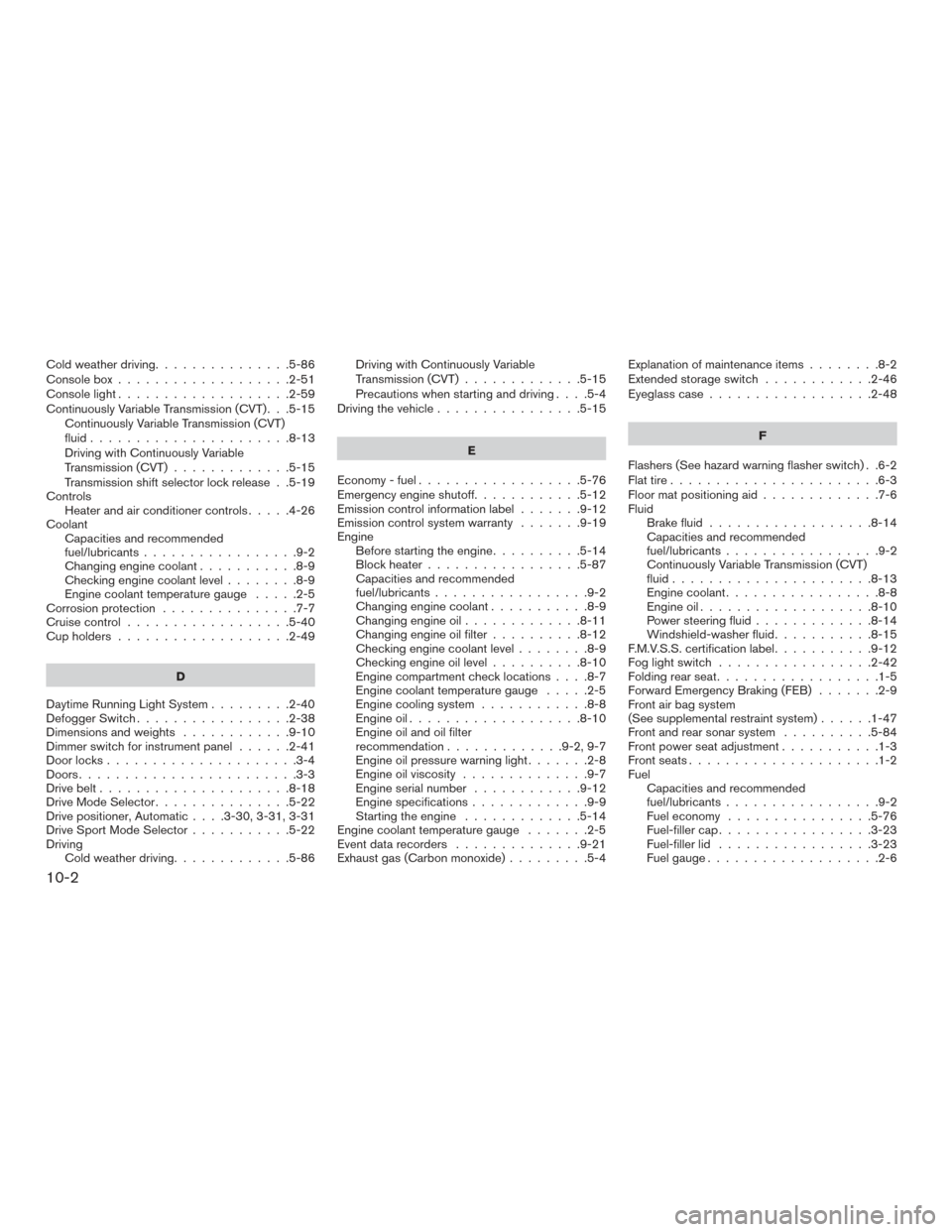
Cold weather driving...............5-86
Consolebox...................2-51
Consolelight...................2-59
Continuously Variable Transmission (CVT) . . .5-15 Continuously Variable Transmission (CVT)
fluid ......................8-13
Driving with Continuously Variable
Transmission (CVT) .............5-15
Transmission shift selector lock release . .5-19
Controls Heater and air conditioner controls .....4-26
Coolant Capacities and recommended
fuel/lubricants .................9-2
Changing engine coolant ...........8-9
Checking engine coolant level ........8-9
Engine coolant temperature gauge .....2-5
Corrosionprotection ...............7-7
Cruisecontrol..................5-40
Cupholders...................2-49
D
Daytime Running Light System .........2-40
Defogger Switch .................2-38
Dimensionsandweights ............9-10
Dimmer switch for instrument panel ......2-41
Door locks .....................3-4
Doors ........................3-3
Drive belt .....................8-18
Drive Mode Selector ...............5-22
Drive positioner, Automatic ....3-30,3-31,3-31
Drive Sport Mode Selector ...........5-22
Driving Cold weather driving .............5-86 Driving with Continuously Variable
Transmission (CVT)
.............5-15
Precautions when starting and driving ....5-4
Driving the vehicle ................5-15
E
Economy - fuel ..................5-76
Emergency engine shutoff ............5-12
Emission control information label .......9-12
Emission control system warranty .......9-19
Engine Before starting the engine ..........5-14
Block heater .................5-87
Capacities and recommended
fuel/lubricants .................9-2
Changingenginecoolant...........8-9
Changingengineoil.............8-11
Changing engine oil filter ..........8-12
Checking engine coolant level ........8-9
Checking engine oil level ..........8-10
Engine compartment check locations ....8-7
Engine coolant temperature gauge .....2-5
Engine cooling system ............8-8
Engineoil...................8-10
Engine oil and oil filter
recommendation .............9-2,9-7
Engine oil pressure warning light .......2-8
Engine oil viscosity ..............9-7
Engine serial number ............9-12
Engine specifications .............9-9
Starting the engine .............5-14
Engine coolant temperature gauge .......2-5
Eventdatarecorders ..............9-21
Exhaust gas (Carbon monoxide) .........5-4Explanation of maintenance items
........8-2
Extended storage switch ............2-46
Eyeglass case ..................2-48
F
Flashers (See hazard warning flasher switch) . .6-2
Flat
tire.......................6-3
Floor mat positioning aid .............7-6
Fluid Brake fluid ..................8-14
Capacities and recommended
fuel/lubricants.................9-2
Continuously Variable Transmission (CVT)
fluid......................8-13
Enginecoolant.................8-8
Engineoil...................8-10
Power steering fluid .............8-14
Windshield-washer fluid ...........8-15
F.M.V.S.S. certification label ...........9-12
Foglightswitch .................2-42
Foldingrearseat..................1-5
Forward Emergency Braking (FEB) .......2-9
Front air bag system
(See supplemental restraint system) ......1-47
Front and rear sonar system ..........5-84
Front power seat adjustment ...........1-3
Frontseats.....................1-2
Fuel Capacities and recommended
fuel/lubricants.................9-2
Fuel economy ................5-76
Fuel-filler cap .................3-23
Fuel-filler lid .................3-23
Fuelgauge...................2-6
10-2
Page 381 of 401
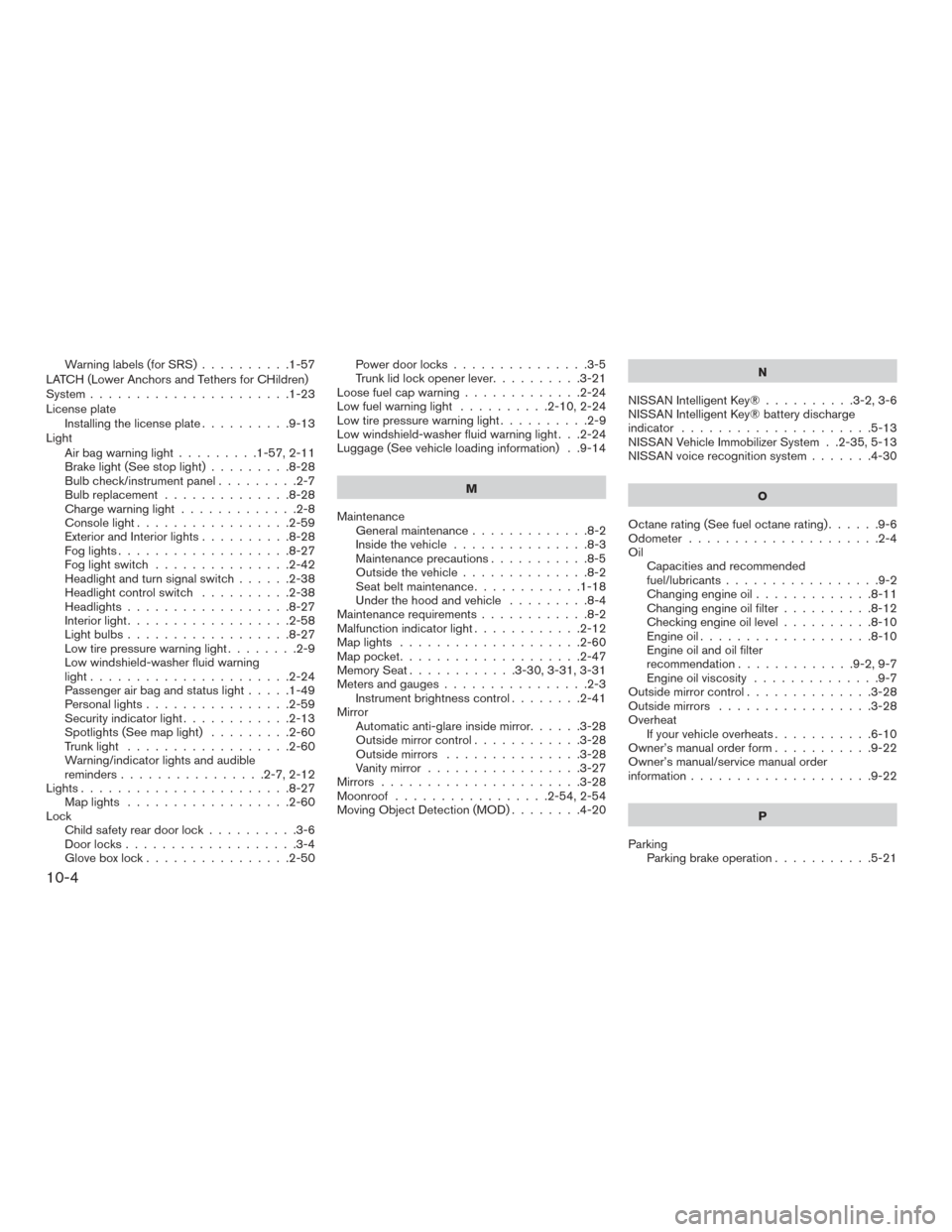
Warning labels (for SRS)..........1-57
LATCH (Lower Anchors and Tethers for CHildren)
System ......................1-23
License plate Installing the license plate ..........9-13
Light Airbagwarninglight.........1-57,2-11
Brake light (See stop light) .........8-28
Bulb check/instrument panel .........2-7
Bulb replacement ..............8-28
Charge warning light .............2-8
Console light .................2-59
ExteriorandInteriorlights..........8-28
Foglights...................8-27
Foglightswitch ...............2-42
Headlight and turn signal switch ......2-38
Headlight control switch ..........2-38
Headlights ..................8-27
Interiorlight..................2-58
Lightbulbs..................8-27
Low tire pressure warning light ........2-9
Low windshield-washer fluid warning
light......................2-24
Passenger air bag and status light .....1-49
Personal lights ................2-59
Security indicator light ............2-13
Spotlights(Seemaplight) .........2-60
Trunklight ..................2-60
Warning/indicator lights and audible
reminders ................2-7,2-12
Lights.......................8-27 Maplights ..................2-60
Lock Child safety rear door lock ..........3-6
Door locks ...................3-4
Gloveboxlock................2-50 Power door locks
...............3-5
Trunk lid lock opener lever ..........3-21
Loose fuel cap warning .............2-24
Lowfuelwarninglight ..........2-10,2-24
Low tire pressure warning light ..........2-9
Low windshield-washer fluid warning light . . .2-24
Luggage (See vehicle loading information) . .9-14
M
Maintenance Generalmaintenance.............8-2
Insidethevehicle...............8-3
Maintenance precautions ...........8-5
Outside the vehicle ..............8-2
Seatbeltmaintenance............1-18
Underthehoodandvehicle .........8-4
Maintenancerequirements............8-2
Malfunction indicator light ............2-12
Maplights ....................2-60
Map pocket ....................2-47
Memory Seat ............3-30,3-31,3-31
Meters and gauges ................2-3
Instrument brightness control ........2-41
Mirror Automatic anti-glare inside mirror ......3-28
Outside mirror control ............3-28
Outside mirrors ...............3-28
Vanity mirror .................3-27
Mirrors ......................3-28
Moonroof .................2-54,2-54
Moving Object Detection (MOD) ........4-20 N
NISSAN Intelligent Key® ..........3-2,3-6
NISSAN Intelligent Key® battery discharge
indicator .....................5-13
NISSAN Vehicle Immobilizer System . .2-35, 5-13
NISSAN voice recognition system .......4-30
O
Octane rating (See fuel octane rating) ......9-6
Odometer .....................2-4
Oil Capacities and recommended
fuel/lubricants.................9-2
Changingengineoil.............8-11
Changing engine oil filter ..........8-12
Checking engine oil level ..........8-10
Engineoil...................8-10
Engine oil and oil filter
recommendation .............9-2,9-7
Engine oil viscosity ..............9-7
Outside
mirror control ..............3-28
Outside mirrors .................3-28
Overheat If your vehicle overheats ...........6-10
Owner’s manual order form ...........9-22
Owner’s manual/service manual order
information ....................9-22
P
Parking Parking brake operation ...........5-21
10-4
Page 382 of 401
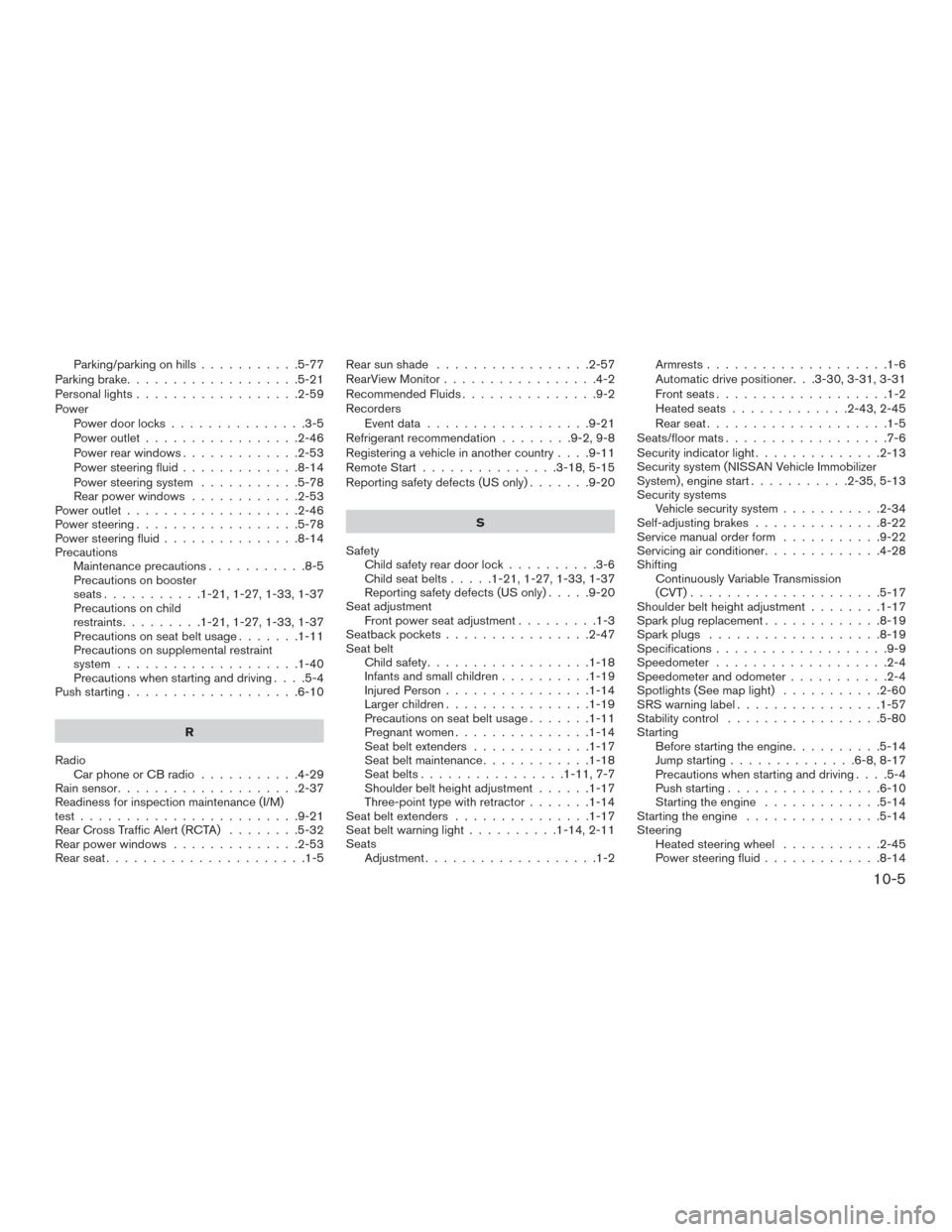
Parking/parking on hills...........5-77
Parking brake ...................5-21
Personallights..................2-59
Power Power door locks ...............3-5
Power outlet .................2-46
Power rear windows .............2-53
Power steering fluid .............8-14
Power steering system ...........5-78
Rear power windows ............2-53
Power outlet ...................2-46
Power steering ..................5-78
Power steering fluid ...............8-14
Precautions Maintenance precautions ...........8-5
Precautions on booster
seats...........1-21,1-27,1-33,1-37
Precautions on child
restraints .........1-21,1-27,1-33,1-37
Precautionsonseatbeltusage.......1-11
Precautions on supplemental restraint
system ....................1-40
Precautions when starting and driving ....5-4
Push starting ...................6-10
R
Radio Car phone or CB radio ...........4-29
Rainsensor....................2-37
Readiness for inspection maintenance (I/M)
test........................9-21
Rear Cross Traffic Alert (RCTA) ........5-32
Rear power windows ..............2-53
Rearseat......................1-5 Rear sun shade
.................2-57
RearView Monitor .................4-2
Recommended Fluids ...............9-2
Recorders Eventdata..................9-21
Refrigerant recommendation ........9-2,9-8
Registering a vehicle in another country ....9-11
Remote Start ...............3-18,5-15
Reporting safety defects (US only) .......9-20
S
Safety Child safety rear door lock ..........3-6
Child seat belts .....1-21,1-27,1-33,1-37
Reporting safety defects (US only) .....9-20
Seat adjustment Front power seat adjustment .........1-3
Seatback pockets ................2-47
Seat belt Child safety ..................1-18
Infantsandsmallchildren..........1-19
Injured Person ................1-14
Largerchildren................1-19
Precautions on seat belt usage .......1-11
Pregnant women ...............1-14
Seatbeltextenders .............1-17
Seat belt maintenance ............1-18
Seatbelts................1-11,7-7
Shoulder belt height adjustment ......1-17
Three-point type with retractor .......1-14
Seatbeltextenders ...............1-17
Seat belt warning light ..........1-14,2-11
Seats Adjustment...................1-2 Armrests....................1-6
Automatic drive positioner. . .3-30, 3-31, 3-31
Frontseats...................1-2
Heatedseats.............2-43,2-45
Rearseat....................1-5
Seats/floor mats ..................7-6
Security indicator light ..............2-13
Security system (NISSAN Vehicle Immobilizer
System) , engine start ...........2-35,5-13
Security systems Vehicle security system ...........2-34
Self-adjusting brakes ..............
8-22
Service manual order form ...........9-22
Servicing air conditioner .............4-28
Shifting Continuously Variable Transmission
(CVT) .....................5-17
Shoulder belt height adjustment ........1-17
Sparkplugreplacement.............8-19
Sparkplugs ...................8-19
Specifications ...................9-9
Speedometer ...................2-4
Speedometer and odometer ...........2-4
Spotlights (See map light) ...........2-60
SRSwarninglabel................1-57
Stability control .................5-80
Starting Before starting the engine ..........5-14
Jump starting ..............6-8,8-17
Precautions when starting and driving ....5-4
Push starting .................6-10
Starting the engine .............5-14
Starting the engine ...............5-14
Steering Heated steering wheel ...........2-45
Power steering fluid .............8-14
10-5
Page 385 of 401
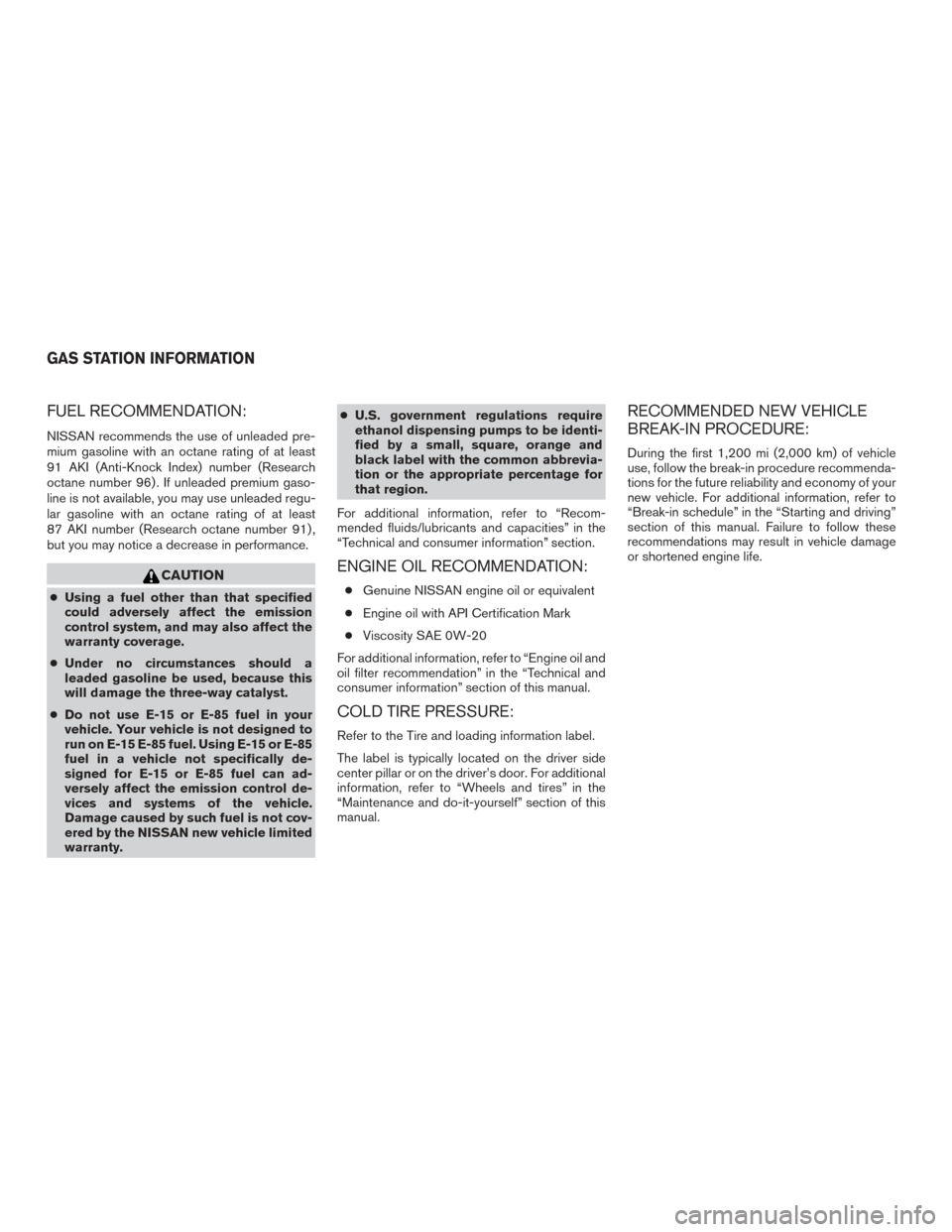
FUEL RECOMMENDATION:
NISSAN recommends the use of unleaded pre-
mium gasoline with an octane rating of at least
91 AKI (Anti-Knock Index) number (Research
octane number 96) . If unleaded premium gaso-
line is not available, you may use unleaded regu-
lar gasoline with an octane rating of at least
87 AKI number (Research octane number 91) ,
but you may notice a decrease in performance.
CAUTION
●Using a fuel other than that specified
could adversely affect the emission
control system, and may also affect the
warranty coverage.
● Under no circumstances should a
leaded gasoline be used, because this
will damage the three-way catalyst.
● Do not use E-15 or E-85 fuel in your
vehicle. Your vehicle is not designed to
run on E-15 E-85 fuel. Using E-15 or E-85
fuel in a vehicle not specifically de-
signed for E-15 or E-85 fuel can ad-
versely affect the emission control de-
vices and systems of the vehicle.
Damage caused by such fuel is not cov-
ered by the NISSAN new vehicle limited
warranty. ●
U.S. government regulations require
ethanol dispensing pumps to be identi-
fied by a small, square, orange and
black label with the common abbrevia-
tion or the appropriate percentage for
that region.
For additional information, refer to “Recom-
mended fluids/lubricants and capacities” in the
“Technical and consumer information” section.
ENGINE OIL RECOMMENDATION:
● Genuine NISSAN engine oil or equivalent
● Engine oil with API Certification Mark
● Viscosity SAE 0W-20
For additional information, refer to “Engine oil and
oil filter recommendation” in the “Technical and
consumer information” section of this manual.
COLD TIRE PRESSURE:
Refer to the Tire and loading information label.
The label is typically located on the driver side
center pillar or on the driver’s door. For additional
information, refer to “Wheels and tires” in the
“Maintenance and do-it-yourself” section of this
manual.
RECOMMENDED NEW VEHICLE
BREAK-IN PROCEDURE:
During the first 1,200 mi (2,000 km) of vehicle
use, follow the break-in procedure recommenda-
tions for the future reliability and economy of your
new vehicle. For additional information, refer to
“Break-in schedule” in the “Starting and driving”
section of this manual. Failure to follow these
recommendations may result in vehicle damage
or shortened engine life.
GAS STATION INFORMATION